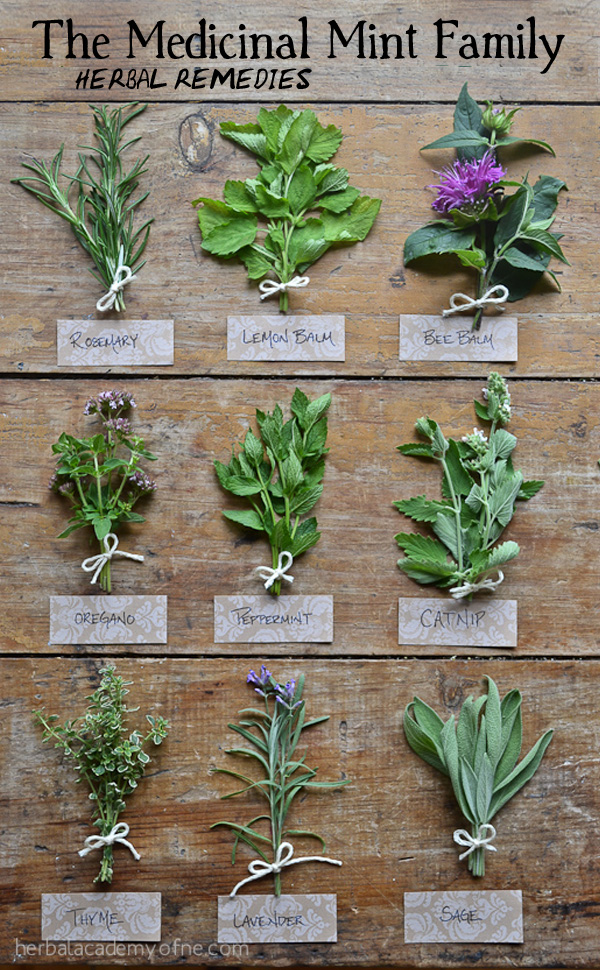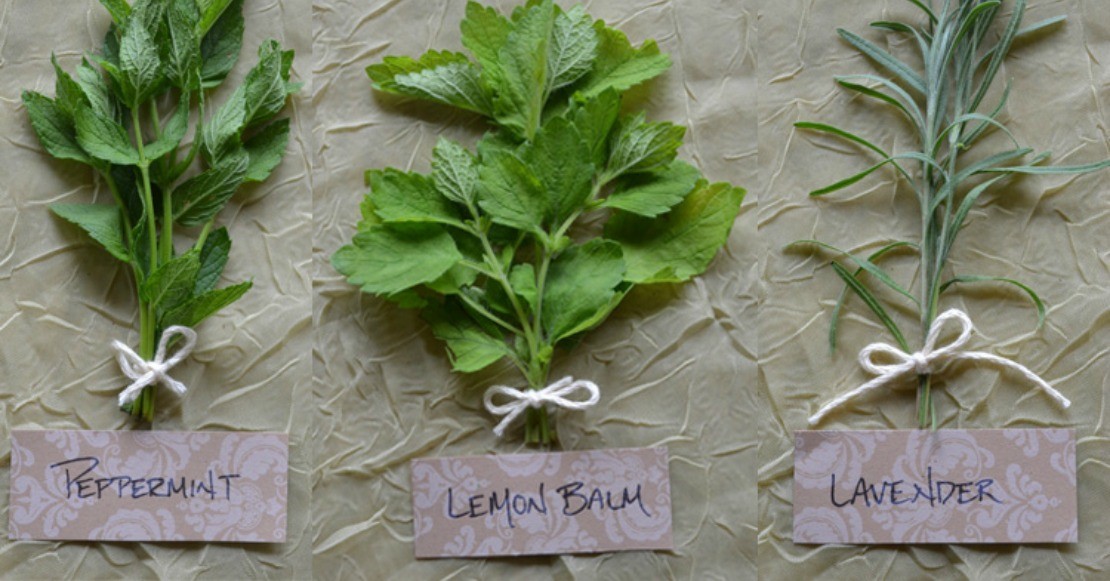
Meet the Mint Family (+ Mint Sun Tea Recipe!)
I walk in my gardens on a July evening, admiring the lush green that abounds in midsummer. The bee balm is chest high and near blooming, the lavender, catnip, and oregano are in full flower; the sage, rosemary, thyme, and basil are growing tender new leaves almost daily; and the peppermint and lemon balm are spreading prodigiously. I check the progress of the bee balm buds as I’ve lately seen a hummingbird, stick my nose in the lavender for a deep inhale, pick a few sprigs of catnip for kitty, and pinch off some basil leaves for pesto, catching the scent of each plant as I go. These plants are all beloved and widely used for culinary, aromatherapy, and medicinal purposes, and they have another important unifying trait — they are all in the mint family, Lamiaceae, which has over 200 genera and 7000 species!
Other common mint family plants include spearmint, hyssop, motherwort, marjoram, skullcap, holy basil, self heal, hore-hound and savory; not to mention the many varieties of mints, such as apple mint, chocolate mint, and pineapple mint.
Mint Family Plant Identification
Mint family plants are birds of a feather, and if you start to observe and compare them, you’ll notice they share the following characteristics:
- Square (four-sided) stems (note that most, but not all mint have square stems, and a few non-mints have square stems but do not smell minty)
- Pairs of opposite leaves that alternate direction and get progressively smaller towards the top of the stem
- Tiny flowers with five united petals (two up, three down) to make upper and lower “lips” that form a tubule (perfect for hummingbirds and butterflies!)
- Flowers arranged in whorls (clusters) at the base of the leaves or at the end of spikes
- Strongly aromatic (almost all of the mint family plants have a strong aroma)
- Likely sitting on your spice rack! (nearly half of common kitchen spices are in the mint family)
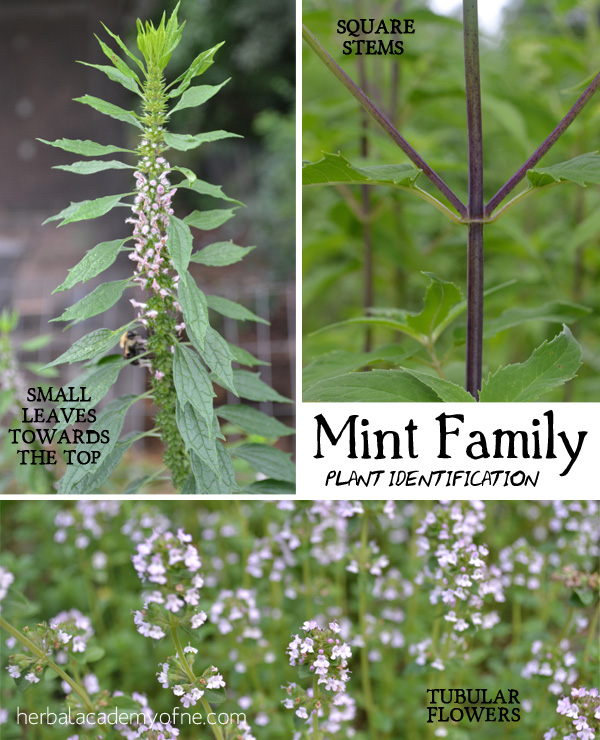
Mint Family Herbal Medicine
The aromatic nature of the mint family plants come from their high levels of volatile oils, which also account for the rich flavors prized in cooking and many of their medicinal properties. While the medicinal actions of the mint family plants make quite a long list, many of them fit into four categories:
- Nervine for nervous system complaints (anxiety, depression, headaches, insomnia, dementia)
- Digestive for digestive system complaints: (indigestion, gas, cramps, nausea, colic)
- Antimicrobial for infections: (bacterial, viral, fungal)
- Clearing for respiratory system complaints (infection, congestion, asthma)
So how do they do it? The answer is in the volatile oils. These plants contain volatile oils such as menthol, thymol, citronellal, limonene, camphor, carvacrol, and linalool, to name a few. Anti-microbial actions aside (we’ll get to that), the primary action of volatile oils is to relax tension and spasm in our internal organs. Our powerful sense of smell is directly connected to the limbic system of the brain, which governs emotion and memory. When we catch the scent of an aromatic plant, nerve endings are stimulated to send impulses to the limbic system and to structures that manage stress in our internal organs; once the volatile oils enter our blood, they relax smooth muscles in the airways and circulatory tissues in the intestines, relieving tension and restoring balance (Masé, 2013). As for the nervine effects, the balanced state created in our internal organs is reflected in our emotional state by a feeling of “being in the flow” or feeling a sense of harmony. Masé (2013) postulates that this is most likely because new smells signify a changing environment and act as a wake up call of sorts, allowing us to move from a stressful state to a calmer state.
As for the antimicrobial action of mint family plants — in short, their volatile oils are great for killing microorganisms, from bacteria and viruses to fungi. In the Middle Ages, aromatics were used as strewing herbs in households during times of sickness and plague to combat ‘evil’, aka microorganisms. And then there’s the infamous legend of the Four Thieves, in which four brothers who set to work robbing graves during the Bubonic Plague purportedly used a blend of herbs (including lavender, rosemary, and peppermint) to protect themselves from infection. Modern day scientific research substantiates the antimicrobial action of plants in the mint family for such ailments as colds, influenza, upper respiratory infections, bronchitis, pneumonia, and herpes simplex (cold sores), just to name a few.
And what could be more heavenly than mint family aromatherapy as a sinus infection remedy? Whether it’s a cup of peppermint tea for nasal congestion, a thyme facial steam to calm coughs, or hyssop syrup to move lung congestion, the aromatic action of these mint family plants relaxes the tissue of the respiratory system and opens the airways, allowing congestion to move out and breath to flow freely.
Mint Family Herbal Remedies
There are so many easy ways to integrate the uplifting, soothing, and delicious nature of mints into your day — lemon balm glycerite to uplift the mood, a bowl of tabbouleh with spearmint for lunch, a cup of cold peppermint tea for a mid-afternoon pick-me-up, a whiff of lavender essential oil during rush hour traffic, a soothing cup of catnip tea after a meal, or an invigorating foot mas-sage with rosemary oil at day’s end. Here are a few simple recipes to try.
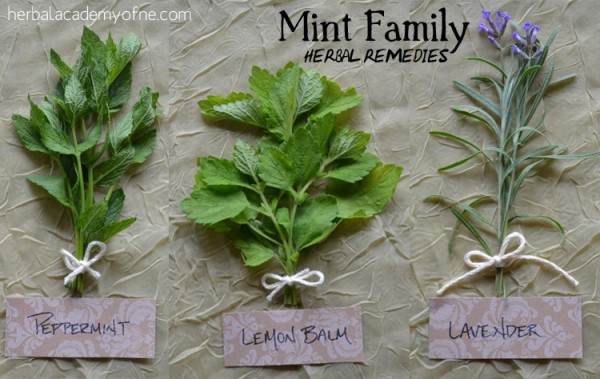
Peppermint Sun Tea
A wonderfully cooling pick-me-up for a hot summer’s day.
1/2 cup dried or 1 cup fresh peppermint leaves
1/2 gallon tap water
- Place peppermint and water in a 1/2 gallon glass jar.
- Set in a sunny place for 2-8 hours.
- Refrigerate and enjoy as a cold drink.
Tummy Tea
The nervine and digestive actions of these plants make a soothing blend for tummy aches, colds, and restlessness at bedtime. This is an especially nice blend for children.
- Mix equal parts catnip, lemon balm, and chamomile thoroughly in a jar, cap and label.
- To brew tea, steep 1 tbsp of tea blend in 8 ounces of boiled water and let steep for 3-4 minutes.
- Sweeten to taste (or not) and enjoy.
- Note that the chamomile will become bitter if steeped for too long.
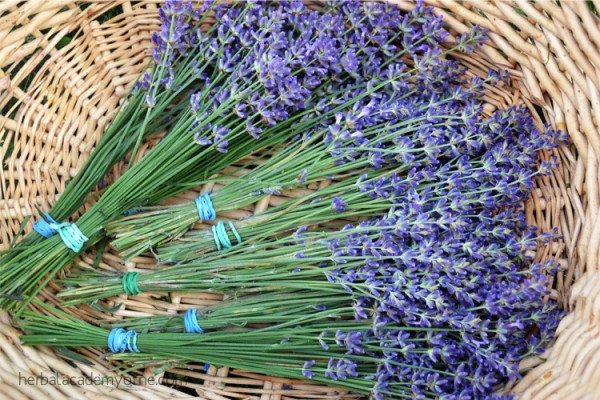
Lavender Honey
Delicious on toast, tea, or yogurt; and a soothing anti-infective for burns and wounds.
- Fill a jar 1/4-1/2 full with flower buds, and then fill with honey.
- Poke with a knife or chopstick to mix and remove any air bubbles.
- Let mixture infuse for a week to a month, depending on preferred strength, tasting occasionally until it is perfectly suited to your taste buds.
Ready For More?
Are you interested in learning more about the medicinal and therapeutic possibilities of the mint family plants? Our online herbal courses delve into the use of these plants for nervous system, digestive system, and respiratory system complaints and returning the mind and body to balance. If you are brand new to herbal medicine, join us at the beginner level in the Online Introductory Herbal Course; if you have prior experience, hop in to the Online Intermediate Herbal Course. Here’s to calm minds, open airways, and easy digestion!
REFERENCES
Masé, Guido. (2013). The Wild Medicine Solution. Rochester, VT: Healing Arts Press.

